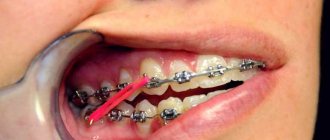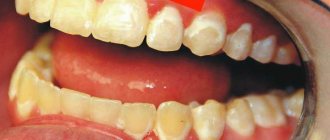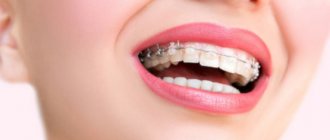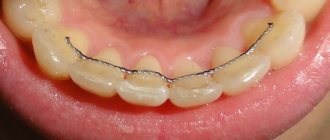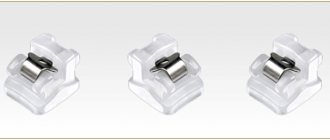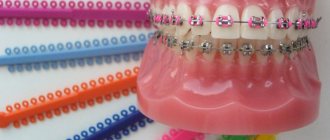According to experts, malocclusions occur in approximately two-thirds of the population of the Russian Federation. It's no surprise that turnkey braces are becoming an increasingly popular service. In Moscow, you will no longer surprise anyone not only with classic metal braces, but also with replaceable aligners, which are less noticeable when you smile. They not only correct the bite, but also help correct the oval of the face. Therefore, by the time the treatment is completed, all patients receive an attractive smile, and the fair sex is additionally pleased with more clearly defined cheekbones and voluminous lips.
What consequences can there be from an incorrect bite?
An incorrect bite negatively affects a person’s health if it is not corrected in time. Abrasion of the tooth edges may occur, and diction may be impaired. Pieces of food get stuck in the spaces between improperly growing teeth, and this is a direct path to the development of caries.
In addition to physiological problems, changes in the oval of the face also occur due to malocclusion. Due to the displacement of the lower jaw, horizontal asymmetry, hollowing or sagging of the cheeks may occur. The line of the mouth also changes - the corners of the lips droop, they become thinner, and do not close completely. The face is changing, and only clinical intervention will save the situation.
Brushing teeth and getting food stuck
Once you get braces, food starts getting stuck everywhere it can. And when elastic chains are attached to the arches, it gets even worse! Orthodontists rightly say that dental hygiene is extremely important when wearing braces! This is true. And “clean” teeth move better. In addition, on the Internet you can find photos of the consequences of poor hygiene. Looks disgusting.
The orthodontist says that it is necessary to brush your teeth after every meal and for at least 10 minutes. The thing about 10 minutes is sacred. That's how it worked for me. But brushing your teeth after every meal is basically unrealistic! In addition, brushing your teeth too often will also not bring anything good. I recommend brushing your teeth 2, or preferably 3 times a day, but no more than three times! Read more about cleaning teeth with braces: brushes and brushes.
At first, I even tried not to go to cafes and restaurants because food would get stuck in my teeth. Score it. Don't deprive yourself of the joys of life! Just always have a toothpick with you. And some water to rinse your mouth.
Chewing gum. They wrote on the forums that it gets stuck in the teeth. Maybe it’s not critical, but I didn’t try it while I was wearing braces. And now I’m out of the habit)
Consequences of frequent and long brushing of teeth
Simple calculations show that toothpaste stays in your mouth and on the skin of your lips and chin for about half an hour every day.
You will most likely experience dry mouth after brushing your teeth. After getting braces, I always started carrying a small bottle of water with me. Drinking clean water is beneficial. But there is a caveat: it is not advisable to drink a lot of water in the evening, especially if you are prone to swelling. I often got out of the situation with a glass of cool, dry white wine in the evening, when I could no longer drink a lot of water. I don’t know how much of a solution this is, but it seems to have helped me. There is another remedy, non-alcoholic;)) - succinic acid in tablets - cheap and useful in all respects.
How to correct a malocclusion
In orthodontics, there are a number of methods that help correct this jaw pathology. The most common of these are braces. They effectively correct malocclusion and dental imperfections. But wearing them is associated with some issues that the patient needs to know about before starting the correction.
Firstly, you need to prepare yourself psychologically that you will now have to wear a non-removable appliance on your teeth for a long time (at least a year). With it you will have to acquire new habits for caring for the oral cavity, in addition, braces change the shape of your face. Why is this happening? To do this, you need to understand how braces work.
Reviews
Correcting a bite is a long and painstaking job, more for the patient than for the doctor. Throughout the treatment he will have to face a number of undesirable manifestations.
What is important here is the psychological attitude and willingness to wear an uncomfortable and unaesthetic design.
If you have already corrected your bite with braces, please share with our readers the changes you encountered during the treatment process. You can leave your entry in the “comments” section.
If you find an error, please select a piece of text and press Ctrl+Enter.
Tags braces before and after
Did you like the article? stay tuned
Previous article
Four designs of one-piece dental implants
Next article
Braces for children - at what age are they placed and which ones are better?
Mechanism of operation of orthodontic structures
Each bracket is fixed to the crown and rotated in the desired plane to rotate and correct the position of the tooth in the row. Braces are made according to an impression of the patient’s jaw, taking into account all individual characteristics. Metal arches put pressure on the crowns, the periodontal ligaments are stretched, and the tooth gradually moves to the desired position. As it moves, the bone tissue is absorbed, and a new one is formed in the previous area.
In addition, other facial structures also change, since they are all connected together. This is why wearing braces inevitably changes the shape of your face.
Changes in bite during treatment
To correct the bite in orthodontics, braces are used. Before installing plates on the teeth, the orthodontist thoroughly studies the anatomical features of the jaw and assesses the severity of the deformation. Before braces, most patients are embarrassed about their smile because a photo of their teeth looks unattractive.
Before correcting teeth with braces:
- the upper canines are knocked out of the general row, since they are cut last and do not fit in the remaining space;
- the front teeth protrude forward due to too narrow a space and overlap each other;
- there are large gaps between the incisors;
- the upper jaw in relation to the lower has a distorted anatomical position.
If you look at the photos before and after treatment, you can doubt the veracity of the result. The position of the jaw changes so dramatically that the patients’ faces become unrecognizable. However, straightening teeth only seems like a simple task. People experience month-to-month changes that are regularly assessed by an orthodontist.
The first changes with braces are noticeable after 2 months. However, wearing braces cannot be canceled at this point. The patient regularly visits the dentist to correct the position of the arch. It is she who creates pressure on the row and corrects its position.
Evenness appears gradually. The time required to completely correct the bite is determined individually. How long the structure will have to be worn depends on the initial condition, type of staples and age of the patient. Metal braces correct deformities faster than aesthetic ceramic or sapphire braces.
What happens to the face while wearing braces?
The extent to which braces can change the shape of the face depends on the degree of tooth deformation and the type of bite that needs to be corrected. The behavior of the patient himself is also important - how accurately he will comply with the orthodontist’s instructions.
When wearing braces, interrelated changes occur in the maxillofacial structures. As they say in this case, braces break the face. The gradual displacement of bone tissue affects the muscles - their tone increases or, conversely, decreases. Let's take a closer look at how individual facial structures change.
Useful tips
Prevention has always been the best way to prevent negative phenomena and complications. According to reviews from patients and dentists, in order to achieve the desired effectiveness of treatment and minimize unpleasant changes, you need to adhere to the following recommendations:
- find a suitable qualified specialist with extensive experience in this field as a treating orthodontist;
- thoroughly treat the oral cavity before installing the system;
- maintain hygiene at the proper level;
- do not miss scheduled doctor’s examinations;
- follow nutritional rules;
- do not refuse to wear retainers.
How does the oval of the face change after braces?
A common question before installing orthodontic structures is whether braces break the oval of the face? Yes, after wearing them, some changes in the shape of the cheekbones and cheeks are possible in some cases. How obvious the changes will be depends on the type and degree of pathology.
Cheeks
The way the overall shape of the face looks, of course, is greatly influenced by the cheeks. Usually, after using braces, they become more sunken, and this is due to the following reasons. The doctor removes the extreme “eights”, which almost always interfere with the correction of the bite. The second factor that affects hollow cheeks while wearing braces is a change in diet. The patient's menu now includes much more liquid food and fewer snacks.
But gradually the place of the removed outer teeth is filled with bone tissue, and the diet becomes more complete as you get used to the braces, and the cheeks can acquire their previous roundness.
Cheekbones
Typically, after braces are installed, cheekbones become more noticeable. This occurs due to some hollowing of the cheeks and changes in facial expressions. If earlier, when smiling, a person tried to hide his teeth by tensing the muscles near his lips, now other muscle structures begin to work.
Nose
How does the nose change after braces? Many people note its slight upturning when wearing vestibular braces on the upper jaw, which persists even after their removal. This occurs due to a slight displacement and restructuring of the cartilage tissue of the nose. But women even like such changes in their faces - a cute upturned nose gives them a special charm.
Chin
Whether the position of the chin will change while wearing braces depends on the initial defect: if before their installation it was moved forward, now it can move back. If the bite defects are insignificant, then there will be no special metamorphosis with the chin.
Lips
Do the lips on the face change when wearing braces? This question especially worries girls. In this case, they even receive a pleasant bonus: now there are arches and braces under the lips, and they become a little plumper. Isn't this what all women dream about? However, after the braces are removed, the effect disappears.
Nose
In patients with a reduced distance between the nose and upper lip and teeth protruding forward, the tip of the nose often noticeably drops down, giving the face a dull appearance, and the lip, on the contrary, protrudes upward. This occurs due to excessive tension in the muscles of the upper lip, which drags the skin along with it. Rhinoplasty is not needed in this case. After treatment with braces, the nose will rise slightly upward, and its owner will probably begin to receive compliments regarding her changed appearance.
Do braces change your face forever?
Often, after removing braces, some experience disappointment when looking at their changed face in the mirror: it seems to them too narrow, and their cheekbones are noticeable. In fact, after braces, the face acquires its natural contours, becomes symmetrical and proportional: with a normal bite and teeth in their place. That is, a person sees in the mirror the appearance that he would have by nature if not for the existing pathology. Many see these changes as positive.
How does your face change after braces are removed? In general, it acquires its natural physiological form. Here are the changes a person may notice:
- the asymmetry of the oval of the face disappears;
- the lip line will become smoother;
- An overly heavy, protruding chin is reduced.
The question of how the face changes after braces can generally be answered in a positive way. With the restoration of the bite, the entire dental system begins to work correctly: the load on the muscles and ligaments is distributed evenly, which helps eliminate visual defects.
Correcting malocclusion is much easier in childhood and adolescence, when the bones of the face are not yet fully formed. But adjustments are also possible in adults, it just takes longer.
However, the problem should not be neglected and a visit to a specialist should not be delayed. The sooner orthodontic treatment is started, the faster its results will be achieved: you will get a symmetrical oval face and will be able to show off your beautiful smile without embarrassment.
The relationship between bite and appearance
We all know that the soft tissues of the face and its overall appearance depend on the structural features of the skull. A special role in the appearance is played by the spatial position of the upper and movable jaw.
Pathologies of occlusion become provocateurs of a number of unwanted problems with appearance, namely:
- thin lips;
- sunken cheeks;
- “strong-willed” chin;
- facial distortion.
Malocclusion can cause premature aging, including the appearance of small and deep folds in the skin.
In orthodontics, there are several types of anomalies, each of which deforms the face to a certain extent.
Distal
The anomaly is characterized by poor development of the movable jaw or excessive protrusion of the upper jaw.
With a prognathic (distal) bite, due to the strong protrusion of the frontal upper elements forward, the chin visually looks small . The upper lip protrudes, and the face looks dazed or tired, even if the person is irritable at that moment or, conversely, is in high spirits.
The problem provokes disturbances in the distribution of chewing loads, which leads to early grinding of the posterior elements of the dentition. The anomaly worsens over time, which is reflected by drooping of the lips at the corners, and as a result, unfriendly and embittered facial expressions.
Deep
This species is characterized by significant overlap of the mandibular incisors with the upper ones. Moreover, the pathology can affect not only the frontal, but also the lateral elements of the jaw arch.
Such closure disturbances entail pronounced changes in appearance. The lower fragment of the face takes on a flattened appearance with the lip turned outward.
If a person with such an anomaly has a narrow frontal area, then the face as a whole looks very small. In those with a high forehead, imbalances in facial proportions become very noticeable.
A person at a subconscious level purses his lips, which helps prevent inversion of the lower skin-muscular fold. These actions, which have become a habit, make your lips visually thinner and your face smaller.
Mesial
This anomaly is characterized by the lower dentition being pushed forward relative to the maxillary arch. This type of occlusion is considered one of the most visually noticeable. Doctors and patients often call the pathology “heavy chin.”
The side outline of a person’s face becomes concave, the chin protrudes, and the upper lip, on the contrary, sinks.
There is mesial occlusion of the lateral sections of the row, as well as direct and reverse bite of the incisors. The progression of the anomaly is accompanied by disturbances in diction and chewing processes.
At the same time, the lower jaw is constantly tense, which increases the load on the muscles of the cervical spine. The person’s face takes on an upset, concentrated look.
Open bite
This pathology is characterized by an occlusal disorder of the relationship of the dentition. There is no contact in the area of the front or chewing teeth when the jaws are closed.
If, when closing, a space between the teeth is formed in the anterior section, then the person’s mouth is always in a slightly open position. This is accompanied by excessive drying of the lips and a change in appearance to a stupid, surprised expression.
The formation of a gap between the lateral teeth entails a violation of the proportions of the face. There is a hollowness of the cheeks , which in appearance resembles the hollows formed with complete edentia.
Crossbite
Cross-type occlusion is an incorrect closure of teeth that occurs against the background of a discrepancy between their size and shape in the transverse plane. The pathology can be unilateral or bilateral.
Both lateral and frontal units may be involved in the process of unfavorable changes.
Crossbite is diagnosed when the upper teeth overlap the lower teeth incorrectly. During the development of the anomaly, a pronounced displacement of one jaw relative to the other is observed.
A person has a need for intensive chewing of food on one of the sides, where the closure of the teeth in the process of physiological activity of the jaws is more or less preserved.
In one area that is constantly involved in grinding food, teeth wear out faster, which leads to quite noticeable asymmetry in appearance.
Why is it recommended to install braces on 2 jaws and how can you save money?
Come here if you are interested in whether they accept braces into the army.
At this address https://www.vash-dentist.ru/ortodontiya/breketyi/podrobno-o-tom-kak-snimayut.html we will find out how to remove braces.
Oral care while wearing braces
It should be remembered that during this period, particularly careful oral hygiene is required. Braces are a non-removable structure, and pieces of food get stuck under them, which need to be removed in a timely manner. Regularly carefully clean the oral cavity and the braces system itself with a special brush every time after eating. While wearing braces, it is advisable to floss to remove food debris between the teeth and rinse them using an irrigator. If you neglect your oral care during this period, your teeth may develop caries.
Negative phenomena
Not every specialist can warn the patient about the negative aspects that arise during the correction process. Bite correction is always accompanied by discomfort at certain stages of changing the position of the teeth.
But this is not the only negative consequence that can be observed. Let's look at common changes that occur during different periods of the defect correction course.
What is the braces activation procedure and how often is it performed?
This publication presents a rating of the popularity of braces systems.
Here https://www.vash-dentist.ru/ortodontiya/breketyi/lechenie-anomaliy-v-30-let.html we will discuss all the pros and cons of installing braces at 30 years old.
Adaptation period
Getting used to it after fixing the system proceeds differently for everyone. This concerns not only sensations, but also the period. You should not rely on reviews from other patients of dental clinics.
On average, the habituation phase lasts from 7 to 14 days.
Common unpleasant points include:
- Hypersalivation . Increased salivation is the body’s response to close contact of tissues with a foreign object. A few days after installation, the body accepts the system, and intense salivation stops. The best advice in this case is to just wait it out.
- Speech disorder .
The problem with diction arises due to the weak interaction of the tongue with the dentition. Changes in pronunciation are most pronounced when wearing lingual systems. Speech is restored after complete adaptation. Experts’ recommendation is to read aloud more, pronouncing every word with expression. - Rubbing the mucous membrane. Patients encounter this problem most often. Not only the locks themselves can rub, but also the fixing elements.
However, after 2-3 days, the inner lining of the oral cavity at the points of contact with the system becomes coarser, and the person ceases to feel the touch of the system’s parts on the lips and cheeks.Orthodontists advise refraining from active lip movements in the first days of treatment, and covering all rubbing parts of the system with special wax.
This will help provide problem areas with a smooth surface and allow the wound area to heal. To relieve pain during the recovery of soft tissues from chafing, it is advisable to use Solcoseryl ointment.
- Painful sensations. Patients note that aching pain often occurs during chewing or when teeth are clenched tightly.
Painful sensations may be completely absent or, conversely, be quite active. There is no need to be patient.It is worth taking an anesthetic drug recommended by a specialist and try to distract yourself from everyday worries. Every day the pain becomes less intense and eventually subsides completely.
Remember! There is no need to be afraid of unpleasant changes after installing braces. The main thing is that treatment has begun and very soon the first positive results will be observed.
Main period
Almost every owner of a braces system is convinced that its effect will occur instantly, after 3-4 weeks of treatment.
In fact, the corrective system does not have magical properties, but helps to slowly bring the dental system back to normal.
The main correction occurs in contrast to the abnormal location and development of the elements of the dentition, so the main period of occlusion correction is delayed for months.
Let us consider the changes in individual segments of the main phase of treatment.
After two months
Most patients note the effectiveness and visual visibility of the result during the first two months of treatment.
This is due to the operation of the arch, which, after installation, automatically takes on the configuration of the incorrect position of the units and pulls the teeth towards itself, forcing them to optimally turn.
But you should not think that if an excellent result is already noticeable, you can remove the system and stop treatment. During this period of correction, the dentition is in an unstable position and will definitely return to its original position.
The period is accompanied by the following negative aspects:
- Slight mobility of teeth due to stretching of the connective ligaments. The symptom disappears on its own within 1-2 months.
- Poor smile aesthetics . During the short period of treatment, a person does not yet have time to psychologically “accept” braces, even if they are miniature in size. He is shy in the company of people, and if he has to smile, it does not happen naturally.
- Caries and damage to the protective layer of teeth. Difficulties with the hyena arise almost immediately after installing the system.
Over the course of two months, bacterial plaque accumulates in hard-to-reach places and provokes the development of caries. To avoid this, it is important to visit your orthodontist regularly for professional cleanings. - Allergic manifestations. The likelihood of allergies at this stage is very high, even though modern designs are made of hypoallergenic materials.
When identifying the first signs of immune system hypersensitivity, it is important to immediately consult a doctor.
Changes over the period from 2 to 6 months
At this stage, the teeth continue to align. There is a need for frequent visits to the orthodontist to correct the arch. Minor pain immediately after adjusting the pressure of the arc on the teeth is inevitable.
Already in the 4th month of treatment, a person ceases to notice the difference in results compared to the first two months. However, the tooth line also continues to straighten, reversing the misalignment of the teeth.
At this stage, the orthodontist can assess the effectiveness of the correction and give the patient a prognosis for all further treatment.
The most dangerous unfavorable moment of this period is considered to be the destruction of the upper part of the tooth roots.
This condition can develop due to strong pressure aimed at displacing pathological elements of the dentition. To detect the problem on time, it is recommended to undergo routine x-rays.
8-12 months of wearing the system
The most important stage. As a rule, at 9-10 months the dentition becomes almost even, and visible changes in appearance are observed.
To improve the outcome of the entire treatment, the orthodontist installs the stiffest archwires. The power of pressure on the teeth increases significantly, and the patient begins to experience severe pain, which can be relieved with painkillers .
Another negative aspect of the period was the use of elastic. A special elastic band for correcting the bite is fixed between the jaws, creating additional discomfort.
The final stage
Once the planned orthodontic treatment is completed and the patient is satisfied with the result, the braces are removed. However, even at the final stage, the patient can expect unpleasant “surprises”:
- Marks on teeth . Very often, after removing the system, patients see stains on their teeth. This is due to insufficient hygiene during the treatment process. It is quite difficult to normalize the color of enamel after its pigmentation.
- Change in appearance . Immediately after removing the staples, a person will see a different appearance in the mirror. As a result of the correction of the bite, the shape of the face becomes oval, nasolabial folds are formed, and the cheek areas recede.
- Leaching of mineral substances from tooth enamel. The design negatively affects the protective layer of teeth over a long period of time.
As a result, the units become sensitive and the enamel becomes thinner. To avoid this, doctors strongly recommend using fluoride-containing rinses during treatment. - High risk of teeth returning to their original pathological position. Although the braces system requires long-term wearing, after its removal the teeth may tend to return to their previous positions.
For this reason, you should not refuse retainers that secure the result, especially if wearing them is necessary for medical reasons. - Dental diseases. If a patient wearing braces has not paid enough attention to oral hygiene, there is a high probability of developing caries and gum inflammation.
Remember! Only a doctor can stop pathological changes and recognize their development in time, so it is recommended to visit the dental clinic more often during the process of correcting the bite.
The video provides an example of the behavior of braces treatment and the visual result.
Types of braces
The most popular dental services in the 21st century are orthodontic, which confirms the existence of many types of braces systems. Their difference lies not only in the materials from which they are made, but also in the places/methods of attachment. Each type has its pros and cons, as well as a number of specific features. For example, there are systems that are divided according to the location of fixation. These include:
- Lingual. They are located on the inside of the teeth, making them completely invisible to others. Most often they are made of metal, but the lead time is much longer than, for example, vestibular ones.
- Vestibular. The most common braces system. It is located on the outer side of the dentition and is used to eliminate almost any bite problems. The disadvantages include the fact that this system is very noticeable to others not only when smiling, but also during a conversation. Due to this feature, many patients refuse this treatment method.
Vestibular on the left, lingual on the right.
Do not forget that braces are a complex structure, which, if displaced, should not be adjusted independently, so it is important to get an appointment with the treating dentist - orthodontist - as soon as possible.
When you can and cannot wear braces
The use of the system is indicated for malocclusion, crowding, and diastema. People of any age can be treated in this way. There are some restrictions for pregnant women, patients with implants, etc.
Who is contraindicated for installing arches:
- persons with acute immunological and neuropsychiatric diseases;
- patients with diseases associated with blood clotting;
- people with bruxism, serious gum pathologies;
- if you are allergic to metal or other materials used.
